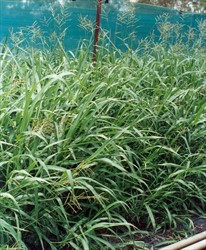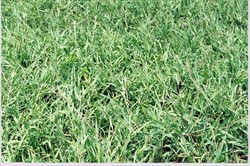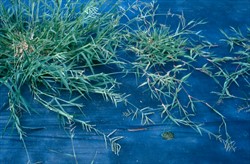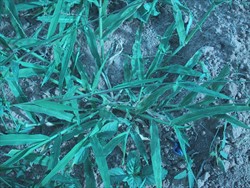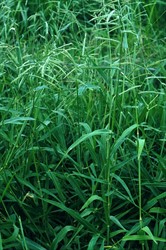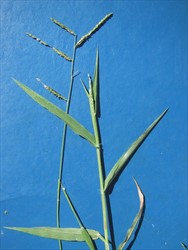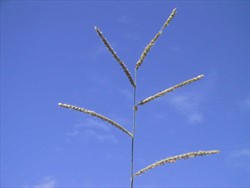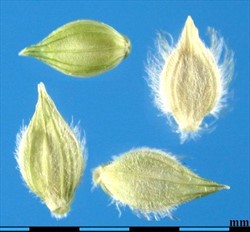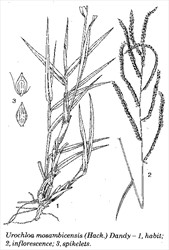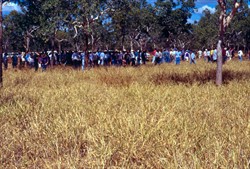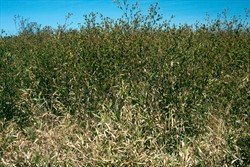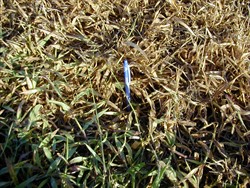Urochloa mosambicensis
Tropical Forages
Urochloa mosambicensis (Hack.) Dandy
Basionym: Panicum mosambicense Hack.; Brachiaria stolonifera Gooss.; Echinochloa notabile (Hook. f.) Rhind.; Urochloa pullulans Stapf; Urochloa rhodesiensis Stent; Urochloa stolonifera (Gooss.) Chippind.
Family: Poaceae (alt. Gramineae) subfamily: Panicoideae tribe: Paniceae subtribe: Melinidinae.
Variable tufted or stoloniferous, rarely rhizomatous, short-lived (3–4 years) perennial; culms 20–150 cm. high, ascending. Leaf sheath with spreading tubercle-based hairs, rarely almost glabrous; ligule a ciliate membrane 1.5–2 mm long. Leaf-blades broadly linear to narrowly lanceolate, 2–30 cm long, 3–20 mm wide, with tubercle-based hairs on the lower surface, less hairy on the upper surface. Panicle comprising (2–) 3–7 (–15) racemes on a common axis 3–12 cm long; racemes 2–8 cm long, bearing single or sometimes paired spikelets on a narrowly winged rhachis. Spikelets ovate, 3–5 mm long, acuminate; lower glume oblong (½–) ⅔–¾ the length of the spikelet, membranous, 3-nerved, often with a tuft of hairs from the middle of the back, obtuse; upper glume glabrous or pubescent, 5-nerved; lower lemma with or without a setose fringe; upper lemma rugulose, with awn 0.5–1.2 mm long. 600,000–1 million seeds per kg.
The morphological diversity of this species is best captured through reference to formerly recognized species.
Stolonifera type: Sward-forming, stoloniferous, sometimes rhizomatous, and tufted with basal nodes swollen; generally smaller than the mosambicensis type, with foliage mostly 10–30 cm, and culms 30–70 (–100) cm tall. Leaf blades 40–130 mm long, 2–9 mm wide. Early or late flowering, with panicle comprising 2–6 racemes, 10–60 mm long; spikelets usually untidily arranged on rachis, 2.5–3 mm long, awn of upper lemma <0.5 mm long, lower glume without stiff hairs on the back.
Mosambicensis type: Stoloniferous and tufted, sometimes rooting and branching from the lower nodes. Culms (30–) 60–100 (–120) cm tall. Basal leaf-sheaths glabrous or hairy, nodes usually hairy; leaf blades usually hairy, 20–300 mm long, 3–20 mm wide. Panicle comprising (2–) 3–15 racemes, 20–100 mm long; spikelets mostly symmetrically arranged in 2 rows on the rachis, 3–5 mm long, awn on the upper lemma 0.5–1.2 mm long. Distinguished from pullulans type in having a tubercle-based bristle in the middle of the lower lemma in the fresh state.
Pullulans type: Tufted, often with robust stolons. Taller than other types, with culms 90–130 (–150) cm. Leaves glabrate. Tends to flower late in the season, usually somewhat sparsely.
Rhodesiensis type: Small and low yielding, mostly with solitary spikelets; little agronomic potential.
Similar species
U. mosambicensis: perennial; lower glume 3-nerved, with 0–3 median bristles; tufted or stoloniferous.
U. brachyura: annual, lower glume 5-nerved, without median bristles, the tip narrowly rounded.
U. oligotricha: perennial; lower glume 5-nerved, without median bristles, spikelets lanceolate; basal sheaths densely hairy; plants rhizomatous.
U. trichopus: annual; lower glume 3-nerved, the middle nerve with 1–5 median bristles; tip broadly rounded or truncate; tufted grass.
Africa: buffelsgras, bosveldbeesgras, kruipsinjaalgras, witbuffelsgras (Afrikaans); tunga (Moçambique); mbawani (Shona), bumbunzwa, mpunga nini (Zimbabwe, Zambia); mfafa, namele, phoka, sugwagwa (Setswana)
English: African liverseed grass, buffalo grass, bushveld signal grass, bushveld herringbone grass, common urochloa, gewone urochloa, gonya grass, paper grass (South Africa); sabi grass (Australia); Mozambique liverseed grass (USA)
Latin America: capim-corrente, capim Chorão, capim urocloa (Brazil); daly (Costa Rica); yerba Mozambique (Puerto Rico)
Asia: ya sabee (Thailand); rumput sabi (Indonesia); mwe-zok-myet, wayon-myet (Myanmar)
Note: Some of the African names may also refer to morphologically similar Urochloa species, particularly the closely related Urochloa trichopus (Hochst.) Stapf.
Native:
Africa: Botswana; Kenya; Malawi; Mozambique; South Africa (Eastern Cape, Free State, KwaZulu-Natal, Limpopo, Mpumalanga, North West Province); Swaziland; Tanzania; Uganda; Zambia; Zimbabwe
Naturalized:
Asia: India (Andhra Pradesh, Tamil Nadu); Indonesia; Sri Lanka; Myanmar; Thailand
Australasia: Australia (Christmas Island, Northern Territory, Queensland, Western Australia)
Pacific: Fiji, Hawaii
Northern America: USA (Texas)
Caribbean: Puerto Rico
Central America: Costa Rica
South America: Bolivia
Forage
A useful, drought-resistant, palatable pasture grass also suitable for hay making.
Environment
It establishes rapidly, is fast-growing forming excellent ground cover, is drought resistant, has moderate salinity tolerance, grows on different soil types over a range of fertility levels, is tolerant of heavy grazing, and is a prolific seed producer, making it ideal for erosion control and other applications where rapid establishment and good ground cover are advantageous. It can be used in veld re-establishment, especially in drier areas, and in the rehabilitation of mine sites. The stolons and broad leaves protect the soil effectively against rain, wind and sun.
Other
In southern Africa the grain of Urochloa mosambicensis is commonly used as a cereal, the ground grain being made into porridge.
Soil requirements
Mosambicensis type: Mostly occurs on sands and sandy loams, but also on clay loams and red clays.
Pullulans type: Found on sands to clay loams, and less commonly, clays.
Collections have been made in soils with pH from 5.8 to 8.5, and available soil phosphorus levels as low as 5 ppm. It has also become naturalized on soils with available P levels as low as 4 ppm. A lthough tolerant of low fertility soils, it responds to improved fertility. Moderate salt tolerance but less than that of Cynodon spp.
Stolonifera type: Found on lighter textured soils from sands to clay loams, sometimes of calcareous origin, near rivers or pans, often in disturbed places.
Moisture
Stolonifera type: Mostly from 800 to 1,000 mm rainfall environments, with the exception of ‘Saraji’, which originates from an area receiving 500 mm/yr.
Mosambicensis type: From 360 to 1,300 (mean 710) mm rainfall environments, usually on well-drained soils and does not tolerate flooding or waterlogging.
Pullulans type: From 700 to 1,600 mm rainfall environments, and often on seasonally flooded soils.
In general, U. mosambicensis prefers well-drained soils and is drought tolerant.
Temperature
U. mosambicensis is mostly found from near sea level to 1,000 m asl, although the mosambicensis type has been collected at 1,500 m asl in Zimbabwe.
Stolonifera type: Largely found between about 22 and 29º S.
Mosambicensis type: This diverse type encompasses a number of the morphological/agronomic groups proposed by various workers. It is found over a similar range to that of the stolonifera type in southern Africa, and extends north to about 4º S in Kenya.
Pullulans type: Largely from more tropical environments between 3º S in Tanzania and 16º S in Malawi.
This is equivalent to a wide temperature range, from about 17 to 24 ºC, and there may well be differences in temperature adaptation among accessions. In general, U. mosambicensis can withstand high temperatures, and can produce some cool season growth if not checked by frost.
Light
Usually found in wooded grassland and deciduous bushland, suggesting it is tolerant of at least light shade.
Reproductive development
U. mosambicensis is an obligate apomict. Many genotypes are day neutral, although short day plants have been identified particularly in the pullulans type. Day neutral types flower continuously from 3 to 4 weeks after the beginning of the wet season, or the commencement of growth after frost, although low temperatures may delay flowering. Flowering continues until growth ceases, with seed maturing in 3–4 weeks.
Defoliation
All U. mosambicensis types are very grazing tolerant, with stolonifera types being particularly stable under heavy grazing or regular defoliation, forming low, dense swards. It has been shown to increase under heavy grazing and dry conditions.
Fire
It starts sprouting quickly after fire, providing soil moisture is adequate.
Guidelines for establishment and management of sown forages.
Establishment
This grass can be established by planting stolon pieces or slips, or sowing seed, usually at 2–4 kg/ha. Seed remains dormant for 6–12 months after harvest, due to physical obstruction of the embryo by the enclosing lemma and palea. Germination of fresh seed can be improved by removal of these glumes, this being achieved effectively by hammer-milling, e.g. 2,400 rpm using a 4.75 mm mesh screen. Seed can be broadcast onto the surface of a well-prepared seed-bed, or placed to a depth of 2 cm. Seed can also be oversown onto undisturbed pasture, although it may take up to 4 years to achieve a good cover of sown grass. Seedlings develop more rapidly than many other warm season grasses.
Fertilizer
Despite growing naturally on soils with low available phosphorus, large responses to applied P have been measured. On very low fertility soils, applications of up to 35 kg/ha P may be necessary to maximise production. A critical P level in the tissue of 0.2% of the DM is proposed. While it can survive on low N soils by virtue of non-symbiotic nitrogen fixation in the rhizosphere, it responds well to applied N.
Compatibility (with other species)
Combines well with legumes, although can dominate in the short term if well fertilized. Good ground cover and rapid Urochloa seedling development contribute to suppression of annual weeds.
Companion species
Grasses: Bothriochloa pertusa.
Legumes: Chamaecrista rotundifolia, Stylosanthes hamata, S. humilis, S. scabra.
Pests and diseases
U. mosambicensis is not subject to major diseases, and has no major pests, although aphids have caused problems in seed crops of ‘Saraji’. It is a host for a number of viruses, including Maize dwarf mosaic virus, which also infects Zea mays and Cenchrus americanus, as well as Sugarcane mosaic potyvirus, Barley yellow dwarf luteovirus, Elephant grass mosaic virus, a Brachiaria (Urochloa) potyvirus and Johnsongrass mosaic virus.
Ability to spread
Stoloniferous forms spread locally by stolons, and free-seeding types disseminate widely as shown by extensive naturalization.
Weed potential
Although listed in some weed lists, it is too palatable and insufficiently aggressive to become a serious weed. However, it is regarded as an environmental weed in parts of northern Australia.
Nutritive value
Like most tropical grasses, U. mosambicensis follows the C4 photosynthetic pathway, which has implications with respect to nutritive value. Protein levels, IVDMD and other measures of nutritive value vary with age of regrowth and soil fertility. CP levels in immature growth of fertilized grass can approach 20%, and IVDMD 65–70%. These values may decline to less than 10% CP and 40–50% IVDMD in mature material. Phosphorus levels in young grass on infertile soil are a little over 0.1%, but can rise to 0.6 or more if heavily P fertilized. Sodium levels in stolonifera type material has been measured at 0.6–1.5%, and in mosambicensis type at 0.1–0.9%.
Palatability/acceptability
Livestock selectively graze U. mosambicensis when it is young, and still find it more palatable than many other warm-season grasses when mature.
Toxicity
No toxicity has been recorded.
Feedipedia link
April 2020: Page under construction
Dry matter
DM yields vary markedly with rainfall, and N and P fertility. Generally, annual DM yields are in the range of 1–8 t/ha, even with moderate applications of N. Without superphosphate on low P soils, yields can be <0.5 t/ha DM, whereas with applied P, comparable yields of >5 t/ha DM have been measured.
Animal production
When grown with Stylosanthes humilis in the seasonally dry tropics, ‘Nixon’ has produced live-weight gains of the order of 80–360 kg/ha/year, with stocking rate extremes of one beast to 0.4–1.6 ha. Increased production at higher stocking rates reflect increasing legume proportions in the pasture.
An aposporous apomict with various chromosome complements.
Stolonifera type: no data.
Mosambicensis type: 2n = 28, 42.
Pullulans type: 2n = 28.
A chromosome number of 30 has also been reported.
Three, and up to 5 harvests per season are possible with day neutral varieties, but only a single harvest from short-day varieties. Seed is harvested by direct heading, producing seed yields of (80–) 100–190 (–220) kg/ha/harvest, and 300 kg/ha or more per year.
Controlled by glyphosate at normal rates. Tolerates atrazine at 4 L/ha.
- Adapted to various soil types.
- Establishes quickly.
- Very palatable.
- Tolerates heavy grazing.
- Mostly good seed production.
- Mostly does not grow on heavy clays.
- Early flowering and seed set of day neutral types reduces period of high quality feed.
- Plant and leaf structure deteriorates rapidly with onset of dry season.
Bogdan, A.V. (1977) Tropical Pasture and Fodder Plants. Longman Inc., New York, USA. p. 295–296.
Burt, R.L., Sinclair, D.F., Harrison, P., Pengelly, B.C. and Williams, W.T. (1980) Preliminary agronomic evaluation of some perennial Urochloa species over a range of environments. Australian Journal of Experimental Agriculture and Animal Husbandry 20:439–446. doi.org/10.1071/EA9800439
Burt, R.L., Williams, W.T., Gillard, P. and Pengelly, B.C. (1980) Variation within and between some perennial Urochloa species. Australian Journal of Botany 28:343–356. doi.org/10.1071/BT9800343
Clayton, W.D. and Renvoize, S.A. (1982) Gramineae (Part 3). In: Polhill, R.M. (ed) Flora of tropical East Africa. Royal Botanic Gardens, Kew, UK.
Harwood, M.R., Hacker, J.B. and Mott, J.J. (1999) Field evaluation of seven grasses for use in the revegetation of lands disturbed by coal mining in Central Queensland. Australian Journal of Experimental Agriculture 39:307–316. doi.org/10.1071/EA98119
McIvor, J.G. (1984) Effects of phosphorus and superphosphate on the growth of Urochloa species. Australian Journal of Experimental Agriculture and Animal Husbandry 24:571–578. doi.org/10.1071/EA9840571
McIvor, J.G. (1992) Urochloa mosambicensis (Hack.) Dandy. In: Mannetje, L.’t and Jones, R.M. (eds) Plant Resources of South-East Asia No. 4. Forages. Pudoc Scientific Publishers, Wageningen, the Netherlands. p. 230–231. edepot.wur.nl/327785
Pengelly, B.C. and Eagles, D.A. (1999) Agronomic variation in a collection of perennial Urochloa spp. and its relationship to site of collection. Genetic Resources Communication No. 29. CSIRO Tropical Agriculture, St Lucia, Australia. bit.ly/2wQJ89A
Whiteman, P.C. and Gillard, P. (1971) Species of Urochloa as pasture plants. Herbage Abstracts 41:351–357.
‘Nixon’ (CPI 6559) Released in Northern Territory, Australia (1973). Institutional collection from Sabi Valley, Zimbabwe. A mosambicensis type, best adapted to tropical monsoon conditions with a rainfall of 600–1,200 mm and a dry season of 5–9 months. Suitable for use on a wide range of soils from clay loams to sandy soils, but appears most suitable for the lighter soil types. Not suitable for flooded sites.
‘Saraji’ (CPI 60128) Released in Queensland, Australia. From Mpumalanga, South Africa (25º S, 1,000 m asl, rainfall 500 mm). Low growing (±40 cm); stolonifera type. Selected for seedling survival and ground cover under conditions of below average rainfall. Used for revegetation and stabilisation of moderately alkaline (pH 8) and saline mine (E.C. = 7.4 mS/cm) spoils.
'Tarwan' Released in Queensland, Australia (2010). Discovered by the breeder in Feb 2004 as a morphologically distinct dwarf U. mosambicensis growing on “Wainui” near Taroom (QLD). ‘Tarwan’ has bred true-to-type for 3 generations of repeated harvesting and planting of the seed by the breeder while making further observations on its morphological and agronomic characteristics, including post-harvest seed dormancy.
The following lines were all identified as having merit in screening trials in tropical and subtropical Australia.
CPI 46876 Origin unknown. Institutional collection from Swaziland. Robust mosambicensis type. Consistently high-yielding across a range of tropical and subtropical sites.
CPI 46935 Origin unknown. Institutional collection from Ilonga Research Centre, Tanzania (500 m asl). Introduced as U. pullulans. Decumbent growth habit, and high stolon density. Very high dry matter yield. Failed to flower at 27º S, but did flower at 19º S, although somewhat sparsely.
CPI 47037 Origin unknown. Institutional collection from Mlingano Research Station, Tanzania. Introduced as U. pullulans.
CPI 60147 Origin Moçambique (16º S, 600 m asl, rainfall 1,600 mm). Introduced as U. pullulans.
The group below have been identified as having an outstanding combination of high dry matter yield, stolon number and stolon length.
CPI 60115 Origin Balantyre, Malawi (16º S, 60 m asl, rainfall 700 mm). Pullulans type.
CPI 60132 Origin Same, Tanzania (04ºS , 700 m asl, rainfall 750 mm). Pullulans type.
CPI 60144 Origin Morogoro, Tanzania (07º S, 700 m asl, rainfall 800 mm). Pullulans type.
CPI 60148 Origin Beira, Moçambique (20º S, 45 m asl, rainfall 1,200 mm). Mosambicensis type.
CPI 60159 Origin Bihari Beach, Tanzania (07º S, 45 m asl, rainfall 1,100 mm). Pullulans type.
CPI 115793 Origin Chinhoyi, Zimbabwe (17º S, 1,120 m asl, rainfall 820 mm). Mosambicensis type.
